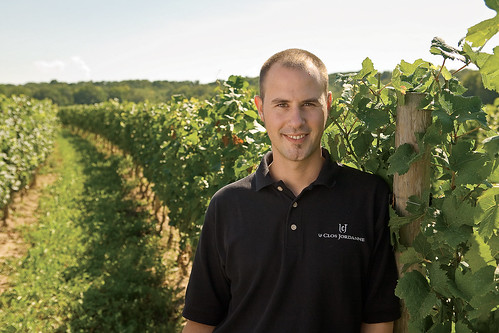
We’re in the quaint village of Jordan settling into our table at the Zooma Zooma Café. Bottles of Le Clos Jordanne’s new 2009 Pinot Noirs and Chardonnays are spread out across the table in the centre of the café.
It’s not an uncommon sight for regulars at Zooma Zooma, but more than a couple of visitors are drooling over the bounty of wine we’re about to dig into on a bright sunny day following 10 days of intense rains in Niagara.
Winemaker Sebastien Jacquey is effusive in his praise of the 2009 vintage for Niagara Pinots and Chards.
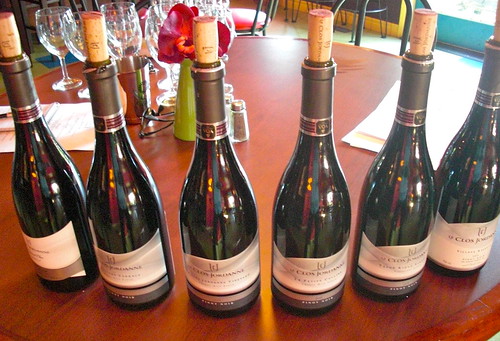
“We won’t have another year like 2009 for Pinot Noirs for probably 10 years,” he says as he opens up the lineup of six Pinots and five Chardonnays that make up the entire Le Clos Jordanne portfolio.
Le Clos is a joint venture between Vincor Canada and the Boisset family from France. It only makes two varieties from estate-grown Pinot Noir and Chardonnay.
The founding viticulturist and winemaker, Thomas Bachelder, nurtured the brand through five vintages before turning it over to Jacquey in 2009. The 2009 vintage was started in the vineyards by Bachelder and finished in the winery by Jacquey, whose first full vintage from bud break to bottle will be 2010.
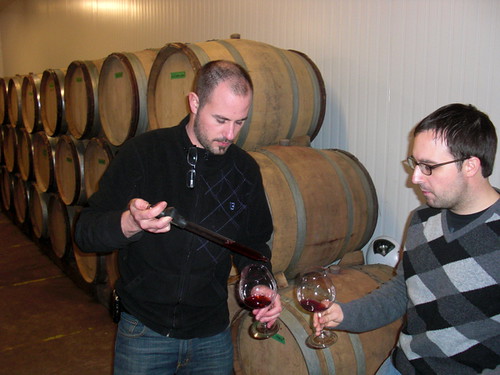
The vintage, which didn’t look spectacular as it unfolded in Niagara during the rather unspectacular summer of 2009, was surprisingly kind to Pinot Noir.
Jacquey called it Niagara’s most “Burgundian vintage we have produced yet.”
The growing degree days in 2009 were the lowest of the past six years. April saw a lot of rain; May was drier and the temperatures were seasonal. June and July were cooler than normal which helped prevent many of the typical disease pressures from developing. August was closer to seasonal temperatures. Disease pressure remained low, and was not an issue by the time the grapes were harvested.
September was perfect for Pinot Noir and Chardonnay with sunny, dry conditions and average temperatures of 22C and cool nights. Grapes had a long ripening period of about a month and were ready for harvest around the beginning of October. Acidity in both Pinot Noir and Chardonnay was high and sugar levels were around 22 brix.
Harvest occurred under sunny and dry — but cool — conditions at the end of an Indian summer.
Jacquey says the vintage delivered exactly what he wanted: balance, colour and acidity. “We did everything the way wanted without compromising.”
He said the wines offer “a good presentation of terroir.”
Here is the lineup of 2009 wines (and a profile of the vineyards, as described by the winery, where they are grown) just being released through Vintages or you can buy at the Jackson-Triggs Winery retail store in Niagara-on-the-Lake.
Le Clos Jordanne Vineyard and the wines
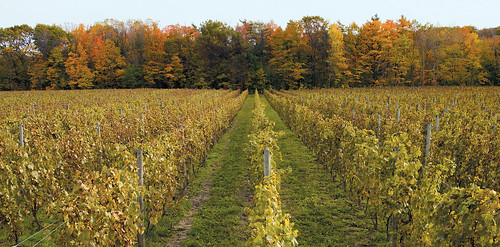
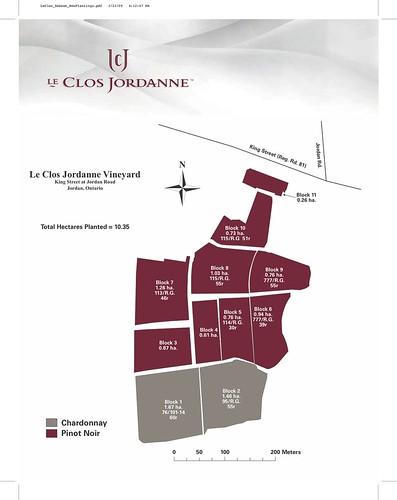
The estate’s principal vineyard is characterized by its tranquility and unique setting on a natural plateau near the slope of the escarpment. It enjoys light limestone soils created by the ancient ice shield, with rich sediments. Its wines are considered to be some of the best within the Le Clos Jordanne Estate, falling into the ultra-premium category. It is located at 2738 King Street, Jordan Station, at the T-junction of Jordan Road and Highway 81.
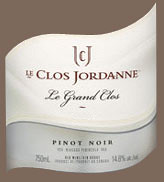 Le Clos Jordanne Le Clos Jordanne Vineyard Pinot Noir 2009 ($45, Vintages, 92 points) — Les Clos Jordanne Vineyard is the warmest of the estate vineyards, producing the ripest fruit. The nose shows raspberry, cherry and plum fruit with tight oak nuances and spice swirling about. It’s juicy and intense on the palate with complex red fruits and some currant and blackberry notes. The texture is dry with soft tannins and nice wood-oak notes on the finish. Needs a couple of years to show its full potential but decant for a couple of hours if you can’t wait.
Le Clos Jordanne Le Clos Jordanne Vineyard Pinot Noir 2009 ($45, Vintages, 92 points) — Les Clos Jordanne Vineyard is the warmest of the estate vineyards, producing the ripest fruit. The nose shows raspberry, cherry and plum fruit with tight oak nuances and spice swirling about. It’s juicy and intense on the palate with complex red fruits and some currant and blackberry notes. The texture is dry with soft tannins and nice wood-oak notes on the finish. Needs a couple of years to show its full potential but decant for a couple of hours if you can’t wait.
Le Clos Jordanne Le Clos Jordanne Vineyard Chardonnay 2009 ($40, 90 points) — Amazing to realize that this vineyard is only 200 metres from Claystone yet is such a different wine. It has gorgeous, expressive notes of lemon-lime, pineapple, peach, lanoline, buttery-creamy nuances, yet wonderfully integrated, elegant oak tones. It’s layered and textured, with creamy-buttery notes and stone and citrus fruits on the palate. It’s all nicely balanced with juicy acidity and length through the finish. The most approachable Chardonnay at the moment.
Le Clos Jordanne Le Grand Clos Pinot Noir 2009 ($75, 92 points) – Fruit for this top Pinot in the portfolio is sourced from the best block of fruit located on the limestone-rich western side of the Le Clos Jordanne Estate Vineyard. It is much more classically Burgundian in style then, say, the Claystone, and shows more elegance through the profile. The nose displays ripe plum, cranberries, black cherries, loam, cassis, flinty minerality, violets, minty spices and toasted oak-vanilla. It is dry yet persistent on the palate, still super-tight and waiting to open up, but still delivers wonderful red and black fruit intensity and balanced with wonderful spice and the elegance of fine oak. Wait on this, and it will return huge dividends. Potential for seven or more years in the cellar.
Le Clos Jordanne Le Grand Clos Chardonnay 2009 ($65, 91 points) — The nose displays a good fruit attack from the get-go with tropical notes, lime-citrus, honey and bright fresh apples that’s neatly stitched together with soft spice, oak tones and chalky minerality. On the palate, this grandest of the Clos Chards, shows laser sharp acidity, exciting tension in the mouth, juicy fruits, chalky stone minerals, and vanilla-brioche flavours all bathed in fine oak that enhances, rather than smothers, the fruit. A very fine Chardy that will get even better with age.
Claystone Terrace Vineyard and the wines
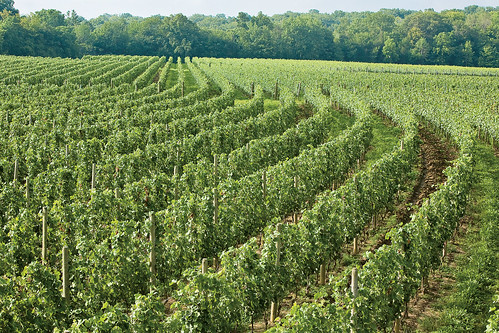
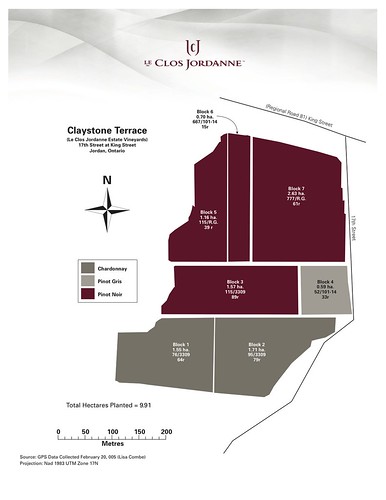
The estate is characterized by its heavier, dark clay soils which retain more moisture. Its first wines have been described as robust and masculine in character, with rich fruit tightly wound around a core of minerality, acid and tannin. It is located at 17th Street and King Street, Jordan.
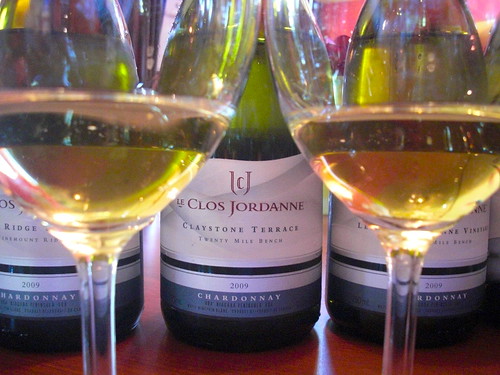
Le Clos Jordanne Claystone Terrace Pinot Noir 2009 ($40, 92 points) – I find Claystone to be the most expressive of its terroir over all the other wines the Le Clos portfolio. It is always a bold, forward expression of Pinot Noir and Chardonnay and, in a great vintage such as 2009, that is especially true. The nose is forward and overt with field raspberry, underbrush, game, earth, black fruits, mineral, kirsch and oak-inspired spices. It needs time to integrate fully, as do all Claystone wines, but, wow, the palate is extraordinary now with an array of dark and red fruits, limestone minerality, beautiful oak and spice notes, rich tannins, and persistent flavours that linger on the finish. I wouldn’t open it for two years at least, or decant overnight. This will deliver rich rewards after a few years of aging.
Le Clos Jordanne Claystone Terrace Chardonnay 2009 ($40, 89 points) — A nose that’s very tight at the moment but shows flinty minerality, wood smoke, lemon and bright apple notes as it opens up in the glass. On the palate, it’s a fresh attack of stone fruits, minerals and spice with a firm core of racy acidity and creamy oak spices. Cellar for three to five years.
La Petite Colline Vineyard and the wine
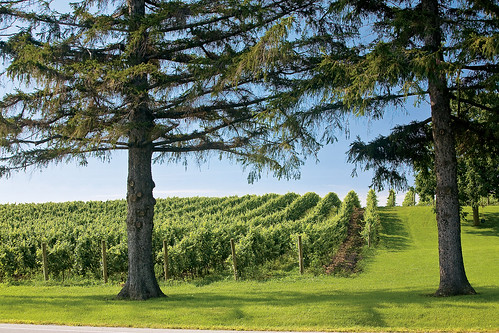
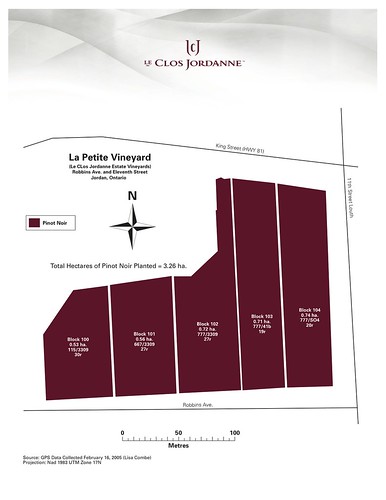
This the smallest of the vineyards and the most easterly, located two kilometres east of the Le Clos Jordanne Vineyard and Claystone Terrace. Its sandier soil means better drainage and slightly warmer temperatures, which have a more pronounced effect on its wines. On the other hand, it requires more care in the heat of the summer. It is located at 11th Street and Robbins Avenue, Jordan.
Le Clos Jordanne La Petite Colline Pinot Noir 2009 ($45, 89 points) – The most thought-provoking Pinot in the collection. The nose is laced with stony minerality, red currants, bramble fruit, violets, savoury spices and wood smoke. It is a powerful Pinot in the mouth, still very young and somewhat tight, but revealing cranberry-cherry flavours, a core of minerality, lovely spice box notes, cedar and texture built around of core of plush tannins. It’s smooth and balanced through the finish with firm acidity.
Talon Ridge Vineyard and the wine
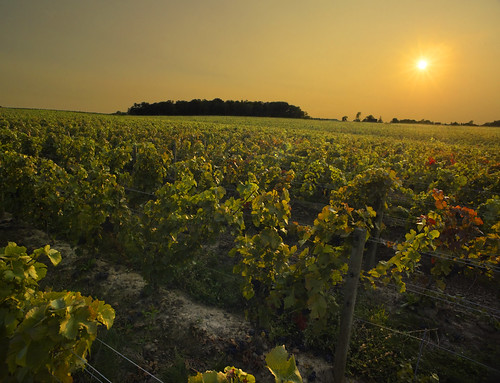
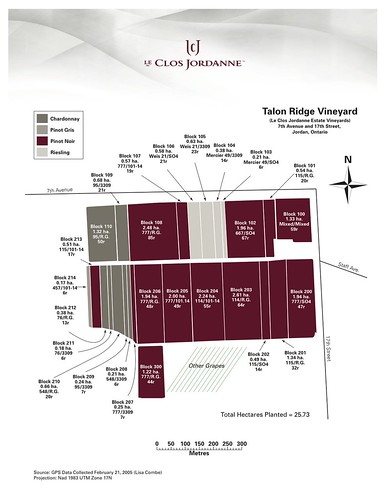
This is the largest of the four vineyards and, unlike the others, is located at the top of the escarpment rather than at its base. It also faces south rather than north, which makes it less influenced by Lake Ontario’s warming effect, but is more influenced by the natural sunshine of a southerly slope. Its soils are stonier, with higher silt and are more vulnerable when it rains. As a result of its cooler temperatures, the vineyard’s wines are lighter and fruitier. It is located at 7th Avenue and 17th Street, Jordan.
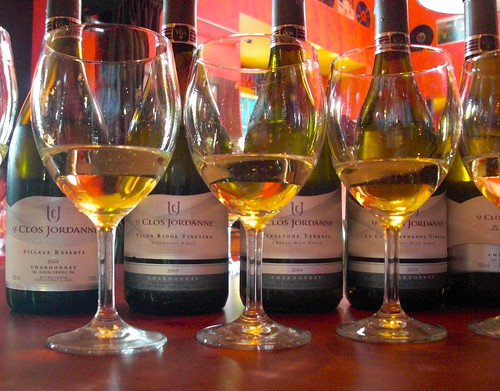
Le Clos Jordanne Talon Ridge Pinot Noir 2009 ($40, 89 points) — Talon Ridge is the youngest of the vineyards situated in the Vinemount Ridge sub-appellation (the rest of the vineyards are in the Twenty Mile Bench sub-appellation). This Pinot Noir is racked only once during aging to make it more approachable upon release. It is, indeed, expressive on the nose with red and dark berries, plums, vanilla, spice, pepper and even a touch of anise. It displays ripe black cherries on the palate, good structure, some minerals and integrated spice. Can drink now, but better in a year or so.
Le Clos Jordanne Talon Ridge Vineyard Chardonnay 2009 ($40, Vintages, 91 points, previously reviewed) — The nose shows intriguing gunflint, wood smoke and mineral notes on the nose with poached pear, citrus and a touch of honey. It is youthful and tight, almost a shame to open at this point, but let it breathe a bit and the flavours emerge in the glass. A core of pear-lemon fruit in the mouth with stony minerality, vanilla-nut and toasty oak notes and wonderful acidity that washes over the palate. A beautiful Chardonnay that will benefit from cellaring.
The Village Reserve wines
The Village Reserve wines are blended from the various Le Clos vineyards.
Le Clos Jordanne Village Reserve Pinot Noir 2009 ($30, 88 points) — A note of minerality on the nose to go with black cherry, raspberry and bramble fruits. This is a rich, juicy offering with classic Pinot tension on the palate that’s nicely structured and balanced.
Le Clos Jordanne Village Reserve Chardonnay ($30, Nov. 12 at Vintages, 88 points) — A nose of brioche, green apple, lemon, creamy-butter and spices. It has a juicy core of acidity on the palate and ripe apple-peach-citrus notes to go with subtle minerality and integrated oak and spice.
Enjoy!







Comment here